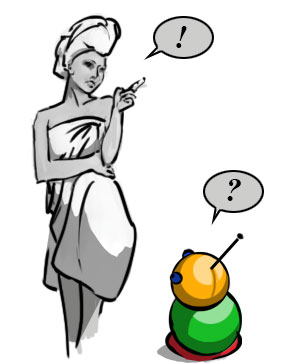
Robohub.org
My robot is smelling my dirty laundry (or, Notes on privacy, PRISM, and home service robotics)

This article considers privacy in robotic systems (such as personal service robotics) as being of greater importance than privacy in telecommunications (such as Internet). We will return to our regularly scheduled program – about gestures and body language – next month.
Let’s say a white box showed up on your doorstep and you open it up and find a little humanoid robot made by Google. A GoogleBot! The brightly-colored pamphlet says that the little disk of a device will vacuum your floor, all for the same cost as your Gmail account: free.
Since you already use Google’s search engine, have a Gmail address, and use GoogleDocs, Voice, Earth, Wallet, wear a Google Glass and have been driving around one of those autonomous cars you’ve been selected as a beta tester! Whee! A free robot!
So what do you do with this thing?
Vacuum the floor, of course. Off it goes, bumping into walls, building its little map as it sucks up Doritos crumbs and dust bunnies.
Google’s greatest hits, like Search, Email, Docs, Voice, or Translation, are founded on, or fodder for, Natural Language Processing technologies (NLP). NLP and other semantic technologies are also why Facebook and, in some cases Apple, has provided us with such great services. They analyze what we write and say.
Meanwhile, others are further ahead of this linguistic learning curve. The National Security Agency (NSA) of the United States was using primitive forms of NLP at least a decade before Google was using it for search. This is common with technologies: Government agencies get theirs first, then the rest of us get to use the stuff later, whether it is global maps of the earth (1650s), satellite photograph (1950s), or GPS (1970s).
Anyway, there are four NSA data collection programs: MAINWAY, MARINA, NUCLEON and – specifically for Internet content, and the most important source of collection – the PRISM project, which by now we’ve all heard about.
On June 6 of 2013 The Washington Post and the Guardian reported that the system draws data from Google, Yahoo, Microsoft and other Silicon Valley giants, keeping the folks in Fort Meade, Maryland busy mining what is the richest depository of personal information in all human history. Evidently the NSA is sucking up 2.1 million gigabytes of data every hour of every day. All information is stored, all communication is monitored, and the fact that someone is peeping in on you has been held secret.
This, of course, has caused some concerns.
These technologies can be used in a predictive manner, as well. What you want, what you think, and what you will do can be predicted with a 93% rate of accuracy, and that includes where you are now and where you will be in twenty-four hours.
We move across a daily landscape of emotions just as we move across a daily landscape of city streets. Semantic analysis (or, more accurately, probabilistic latent semantic analysis, and other technologies that look at our trends) shows where we’ll be and what we are likely to think and feel.
In early December of 2007, Marissa Mayer, now CEO of Yahoo and then the vice president of Google’s Search Products and User Experience division, showed how Google Trends can be used to predict presidential elections. She showed how Google Trends accurately predicted George W. Bush’s win over John Kerry in 2004, and also pointed out how Trends accurately predicted Nicolas Sarkozy’s win in May of 2007, over Segolene Royal in the French elections.
These trickles of valuable personal data add up to rivers of money.
Valuable enough to grow a company into the size of Google, or valuable enough to justify a $10 billion annual NSA budget, those little strings of text add up to lots and lots of real money.
Let’s not forget this Google robot that has shown up on our doorstep. Our big hockey-puck robot (or “connected system” as it is more fashionably called) is buzzing around the floor doing the job for free. This concept is now a prototype and has been operating for three years.
Though iRobot swatted the ConnectR remote-controlled domestic robot in the start of 2009, ending the product line, the concept refused to die. A year later, in March of 2010, the concept was picked up by a group of Swedish hackers who launched a project similar to what I outline above, named GåågleBot (pronounced “GoogleBot”). These Roomba hackers dissected the robot and inserted various items such as a camera, a Wi-Fi card, a small computer, and a good squirt of the AJAX programming language. After sewing it all back up, the thing still maintained operations as a normal Roomba.
The GåågleBot can also read. It comes with optical character recognition (OCR) software so that you (or someone else) can photograph and translate text that happens to be lying around the house, drop it into a database, and run searches on that text. GåågleBot source code and instructions are available for download.
A vacuum is just a vacuum, but these days it is part of what is commonly being called The Internet of Things. Smart Houses, Connected Systems, or Robots … the basic idea is that we use networked computers in objects around us. If we consider the Internet of Things as a physical extension of the Internet we find a new method emerging – as precise as existing analytics systems – that can measure how we each live and spend our money. If you purchase a product, like a watch, and it communicates via a WiFi or Bluetooth network, then whoever or whatever it is communicating with will know where you are, who or what is nearby, your name, movements, past, present and, by prediction, future. Other objects near it will identify themselves and as you synchronize a device with a user account, and the overlapping data increases the relative value of both datasets. Your identity and the identity of you live with will be known by the company you bought it from, of course, and with it will come all of your purchases, likes, dislikes, relationships, and documents that are hanging heavy with fruit to be plucked by the pinchers of NLP and semantic analysis.
Meanwhile, the robot Google sent you rolls around on the floor, sucks up dust, and blinks a network indicator. It seems so humble. But this is how Google, Yahoo, PRISM, the NSA, and therefor the US Government collects data that can be potentially very dangerous information. All from a little vacuum robot. After all, dangerous bombs often come in humble packages.
Now, I don’t mean to sound like the Unabomber here, so I will point you to someone that has thought about this topic far more, and whom I am parrotting, and that is Bruce Schneier. He has written a nice article on this topic, which you can find here.
Let’s not be paranoid. This vacuum, like an email service, may come in handy, and it doesn’t cost anything. So we pull the robot out of the box, flip it on, poke in a password, and go back to eating Doritos.
Now let’s consider another possibility, which is that Google has mailed us not a vacuum hockey-puck, but a little humanoid robot that can walk and grab stuff. GoogleBot is an android that comes up to your knee, just a little guy with big feet and a cute head, kind of like NAO. So you set it down and it begins to explore the house. Sure, for the first few days it is a touch disturbing as it waddles around the house and reads the books on your shelves, and runs optical character recognition on all of your magazines, and seems to be studying the contents of your refrigerator and cupboards and dog food labels and clothing labels, and very carefully watches your television. Once you even see it touching your computer and you chase it away. But eventually it settles down and you think, “That was kind of cute.” Then, finally you get used to it. It does the laundry and feeds the dog, and along the way, GoogleBot gets another cluster of data about your life – and you get your dishes done.
This system may be financed with the same model that Google uses today for things like email, search, voice and other services. Since Google is publicly traded we can see that Amazon paid out $55m in 2011 to advertise for books or whatever. So they would want to know what you buy, what you read, and what you have on the coffee table. Home Depot paid out almost as much, so they would want to know what you have in the yard. State Farm and Progressive insurance companies paid Google nearly $90m, so they would have a great interest in knowing your health habits. All this cascades down into a long list of retail information, health, hygiene, and habits that covers what you are reading, what’s in your yard, what’s in your home, your refrigerator, etc. And so – to be useful – your GoogleBot should be busy dusting your bookshelves, washing your dishes, doing your laundry, and being an active participant in your personal health by cleaning the shower, toilet, and floor.
If someone types in “Self-Employed Health Insurance” and clicks on an ad, Google earns about $43. There are dozens of small robots that cost less than that, which means a home care companion robot of about $500 would amortize GoogleBot’s production cost and shipping in just a few weeks, and become wildly profitable after that robot had spent a year in your home.
Because our personal information is coveted by both corporations and governments, it seems inevitable that this home service robotics model will arrive some day in the coming decade.
Hopefully the GoogleBot or YahooBot or whateverBot will come with bulletproof SHA privacy switches built in, switches we can trust. Hopefully privacy options will allow us to put curtains on the parts of our lives we consider personal. That way we don’t have to stuff the robot in the freezer when the girlfriend comes over. And perhaps even revenue options will let us collect money for the information Google collects about us (Google still wins, we just pay less usage tax). Or perhaps these are added features that we will have to pay for, like in-app purchases today. Perhaps we will have to pay for our privacy.
There are lots of questions here. Least among them are how the NSA and companies like Google and Yahoo work together – and Google in particular has been quick to reply to these questions, as have other companies. They’re now on a mission to regain our confidence. But the NSA remains spooky, holds the reigns, and hides in the shadows. It seems they are collecting as much information as they can for long-term storage. The chief technology officer at the CIA, Gus Hunt, said last March; “We fundamentally try to collect everything and hang onto it forever.”
Any time citizen information is secretly stored by a government, it means that government is collecting the tools of a dictatorship. Just ask Mussolini. Or take a look at how Germans, familiar with the Nacht-und-Nebel program, or Sicherheitsdienst, are reacting this week. Information is generally collected so that it can be used.
Of course the common response is, “I’ve got nothing to hide,” but the bottom line isn’t about having nothing to hide. It’s about not wanting to show everything.
Privacy is about having the decency to wear pants, the right to have curtains, and the right to whisper sweet coo-coos in your lover’s ear without someone else, like GoogleBot, YahooBot and the NSA leaning in for a little listen.
tags: AI, Geppetto Labs, Mark Stephen Meadows, Natural Language Processing, privacy, robot, security




